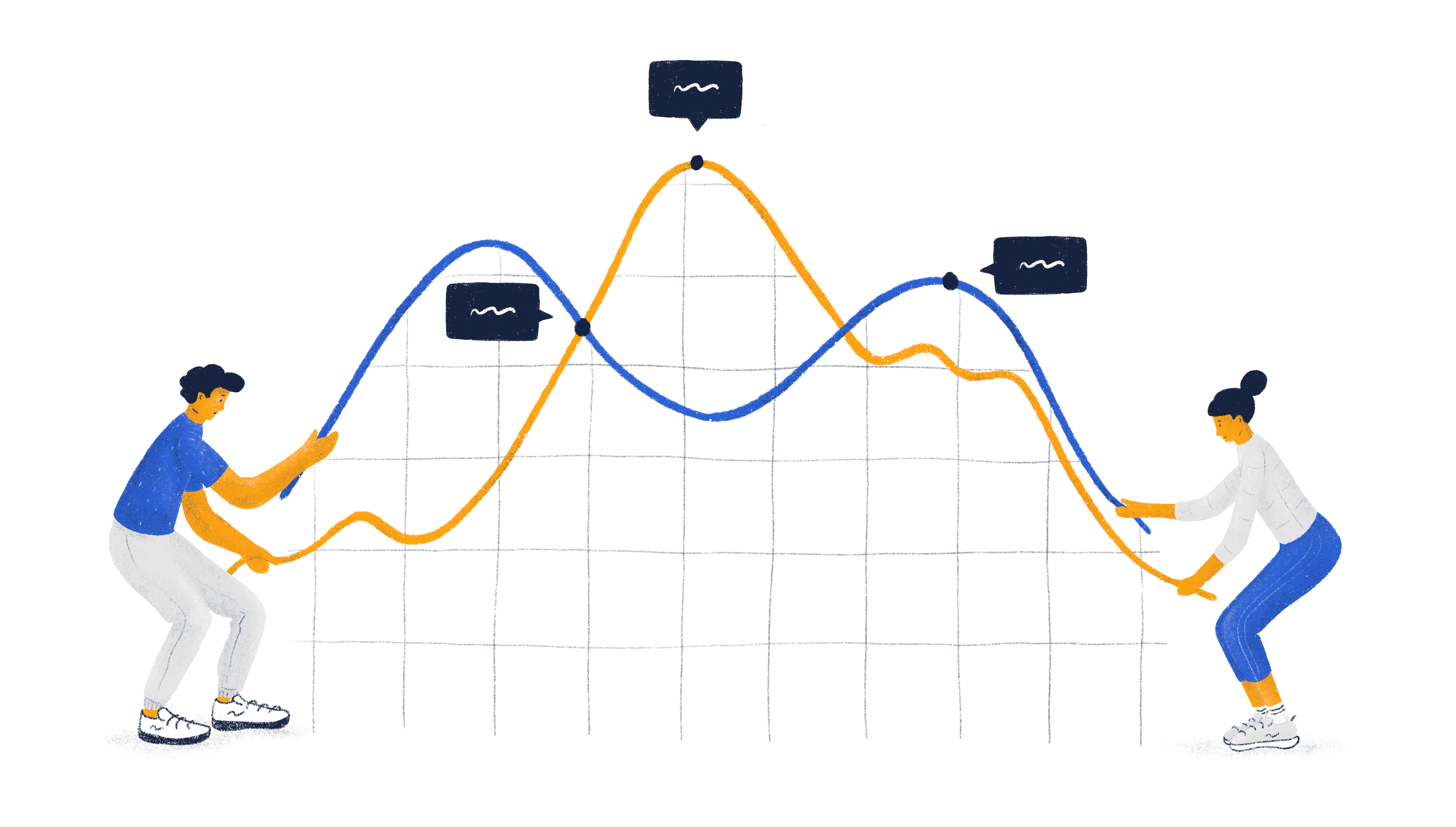Ask any business owner, and they’ll tell you this is the most competitive time in business history.
It’s true. Everyone’s fighting tooth and nail to grab the brass ring. The most successful companies are the ones with bright brand awareness, a phenomenal product, and a sales team that knows how to seal the deal.
But here’s the thing — none of that works without marketing research.
It’s imperative to understand your customer inside and out before kicking off any marketing, which is the tool that connects your audience to your offering, convinces them they need it, and keeps them coming back for more.
Why Marketing Research Matters
According to a Market Research Data Report by Hanover Research:
- 68% of companies that increased sales used market research to do so.
- Businesses that regularly conduct research are 76% more likely to report revenue growth than those that don’t.
- Companies leveraging research see boosts in customer retention, market expansion, and product launches.
The takeaway? Marketing research isn’t just for the big guys — it’s for any business looking to grow smarter and faster.
Who’s This Guide For?
Whether you’re the CEO, the marketing lead, or a one-person show trying to keep the lights on, this guide will help you:
- Find the right audience and understand what makes them tick.
- Create messaging that actually lands.
- Build campaigns that lead to sales.
What Questions Are We Answering?
Before diving into the process, let’s answer a few key questions every marketer should be asking:
- Who’s our target audience?
- What are their pain points?
- How can we solve them?
- Where can we meet them with our message?
- What will grab their attention?
Marketing isn’t magic — it’s a process. And the following sections will show you how to make it work.
We’ll walk you through the key steps of the marketing research process, with a focus on three core areas:
- Industry Research – Know the landscape.
- Competitor Research – Size up the competition.
- Personas – Get inside your customers’ heads.
Plus, we’ll share quick wins and common pitfalls so you can skip the trial-and-error phase and get straight to results.

Key Steps in the Marketing Research Process
Marketing isn’t about shouting louder than the competition. It’s about understanding your audience better than they understand themselves.
Think of this as your roadmap for building a research-driven strategy. The following sections will show you how to apply these steps in the real world.
Step 1: Define the Problem – What are you solving for?
Every great strategy starts by asking the right questions. Without clearly defining the problem, research can become unfocused and ineffective.
Start by identifying the core challenge:
- Are sales declining? If so, is it due to pricing, competition, or weak messaging?
- Who are we targeting? Are we reaching the right audience, or do we need to refine our customer personas?
- What’s stopping customers from buying? Lack of trust, unclear value propositions, or a confusing checkout process?
- Where are we losing opportunities? Are leads dropping off at a specific stage in the funnel?
Example: A SaaS company sees a high trial signup rate but low conversions to paid plans. The core problem? Users aren’t seeing enough value during the trial period. The research process should focus on why that’s happening.
Step 2: Develop a Research Plan – How will you get answers?
Now that you know what problem you’re solving, decide your data collection methods.
Primary Data
Get insights straight from your target audience using a mix of quantitative data (numbers, statistics, trends) and qualitative data (opinions, motivations, behaviors).
- Surveys & Interviews – Learn what customers need, want, and struggle with. (Tools: Google Forms, SurveyMonkey, Typeform)
- Focus Groups & Customer Feedback – Identify pain points and preferences in real-time. (Tools: Zoom, UserTesting)
- Support & Sales Team Input – Your frontline teams often hear objections and concerns firsthand.
- Historical data from contact forms or support tickets – Identify what users are saying in form fields or live chat.
Secondary Data
Your secondary research is sourced from places like industry reports and competitor insights to help supplement your primary research.
- Market Reports & Studies – Learn about trends, customer behavior, and industry benchmarks. (Sources: Statista, IBISWorld, Gartner)
- Keyword Research – Find out what your audience is searching for. (Tools: SEMrush, Ahrefs, Google Keyword Planner)
- Competitor Research – Analyze competitors’ content, SEO, and ad strategies. (Tools: SimilarWeb, SpyFu, Facebook Ad Library)
Example: A direct-to-consumer skincare brand wants to know what influences purchase decisions. Instead of guessing, they run Instagram polls and analyze competitors’ top-performing ads.
Step 3: Collect the Data – Where will the data come from?
Now, it’s time to gather and organize insights. This step ensures your research is grounded in real data, not assumptions.
Types of Data Sources to Leverage
- Website Analytics – Track user behavior (traffic, bounce rates, time on page). (Tool: Google Analytics)
- Social Media Insights – Understand audience demographics and engagement patterns. (Tool: Meta Business Suite, LinkedIn Analytics)
- Competitor Data – Identify high-ranking keywords, backlink sources, and ad strategies. (Tool: SEMrush, SimilarWeb, Facebook Ad Library)
- Customer Feedback & Support Tickets – See recurring pain points directly from your audience. (Tool: Zendesk, HubSpot CRM)
Organizing Your Data
Once you’ve collected insights, sort them into categories:
- Customer Behavior – Who they are, how they browse, what they buy.
- Competitor Insights – Strengths, weaknesses, gaps you can exploit.
- Market Trends – Growing opportunities, shifts in consumer demand.
Example: A B2B SaaS company reviews CRM data and finds that 70% of churned customers never completed onboarding. Their insight? They need a better user onboarding process.
Step 4: Analyze the Data – What’s the story the data tells?
- Are there gaps or untapped opportunities?
- What trends or patterns stand out?
Collecting data is just the start. The real value comes from knowing how to interpret it.
Conversion Rate
Why It Matters: Shows how many visitors take action (buy, sign up, etc.). A low conversion rate signals friction in the user journey.
Where to Find It: Google Analytics, CRM/HubSpot
Customer Lifetime Value (CLV)
Why It Matters: Helps determine how much revenue a customer generates over time. Higher CLV means better retention.
Where to Find It: CRM/HubSpot
Engagement Rate
Why It Matters: Measures how actively users interact with content (likes, shares, comments).
Where to Find It: Company page insights on Linkedin, Page insights on Facebook
Bounce Rate
Why It Matters: A high bounce rate means visitors leave without interacting. This can indicate poor page experience or irrelevant content.
Where to Find It: Google Analytics, Hotjar
Learn more about which marketing metrics to track for each campaign.
Step 5: Turn Insights into Strategies – How will you act on it?
Once you’ve identified trends, it’s time to put them to work. Here’s how to turn raw data into results:
Fix What’s Not Working
- High Bounce Rate? Slow load times, weak CTAs, or unclear messaging could be the problem. Try:
- Improving page speed with image compression and caching.
- Updating CTAs to be clearer and more compelling.
- Refining your messaging to align with audience expectations.
- Low Conversion Rate? Visitors aren’t taking action. To fix this:
- A/B test different offers, button placements, or headlines.
- Optimize landing pages for clarity and ease of navigation.
- Ensure mobile-friendliness—many users drop off due to poor mobile UX.
- Strong Social Engagement? If certain content types are performing well, maximize their impact:
- Repurpose high-performing posts into videos, infographics, or email campaigns.
- Increase ad spend on top-performing organic posts.
- Use engagement insights to guide future content creation.
Refine & Expand Your Strategy
- Update your messaging to better resonate with your audience.
- Adjust ad targeting based on new customer insights.
- Launch new campaigns to fill market gaps.
Start small if needed—focus on one area, like competitor research, and expand your process as you grow.
Are you not ready to tackle the entire process? No problem. Use quick wins to gather insights fast, then refine your strategy step by step.
Quick Wins: Fast-Track Your Research Process

Let’s face it — sometimes you need answers yesterday. For teams tight on time or resources, here are quick wins that deliver insights without the wait:
Industry Insights on the Fly:
- Set up Google Alerts for your industry’s keywords to catch breaking news and trends.
- Use BuzzSumo to track viral topics in your space.
- Leverage Google Trends to identify rising topics and seasonal shifts in demand.
Pro Tip: Combine Google Trends with Google Analytics to compare search interest vs. actual site traffic. If interest in a topic is rising but your traffic isn’t, you may need to optimize content for SEO.
Spy on Competitors
Get a competitive edge without hours of manual research.
- Scan competitor websites with SimilarWeb to uncover traffic sources, audience demographics, and more.
- Browse the Facebook Ad Library or LinkedIn’s Ad Library to see what ads they’re running right now.
- Run your competitor websites through SEMrush or Ahrefs to identify the keywords driving traffic to their website.
Leverage your CRM data for Customer Insights
Your CRM data should be a massive part of your research tools — existing customers are your best source of actionable data.
- Create a segment of your best customers and identify their behavior. Look at the content they view, the sources of traffic they come from, and what messaging resonates.
- For example, in HubSpot, you can filter based on closed won deals (and more parameters) and then analyze contact level behavioral tracking (activity feed) to see how customers interact with your emails, content, and website.
- Analyze deal trends to identify which types of leads are converting — and which are dropping off.
Pro Tip: Start with your 10 best customers (based on deals/opportunities/sales) and work backward to identify common contact behaviors. After analyzing your best customers, set up basic lead scoring based on the data collected.
Build Personas Without the Guesswork:
Know exactly who you’re marketing to.
- Use LinkedIn Audience Insights to learn about your followers’ job titles, industries, and behaviors.
- Survey your sales team for FAQs and customer objections — they’re sitting on a goldmine of data and insights.
- Use Hubspot’s free persona builder to create data-backed customer personas.
Pro Tip: Focus on one area — industry, competitors, or personas — rather than tackling everything at once. Small wins lead to big wins.
Applying the Framework: Focus Areas for Data-Driven Decisions

How to Analyze Trends and Opportunities
Step 1: Gather Industry Insights
- Identify trends, challenges, and growth opportunities through:
- Industry Reports (e.g., Statista, IBISWorld).
- Market Trend Tools (e.g., Google Trends, BuzzSumo).
- Keyword Research (e.g., SEMrush, Ahrefs).
Step 2: Evaluate Market Size & Demand
Use tools like Google Keyword Planner and U.S. Census Data to analyze market size, demand, and customer behavior.
Step 3: Spot Emerging Trends
- Monitor news sites, forums, and social platforms for trends affecting your space.
- Track innovations and regulations that could impact growth.
Key Takeaway:
Build an industry overview report summarizing trends, growth areas, and gaps where you can add value.
How to Size Up the Competition
Step 1: Identify Competitors
- Create a list of direct and indirect competitors.
- Tools to Use: SEMrush, Ahrefs, SpyFu, SimilarWeb.
Step 2: Analyze Their Strategies
- Audit competitors’ websites, ads, and content:
- SEO performance – Keywords and backlinks.
- PPC campaigns – Ad spend and keyword targeting.
- Social Media Engagement – Posting frequency and performance.
Tools to Use: Facebook Ad Library, LinkedIn Campaign Insights, SEMrush Ads Analysis.
Step 3: Assess Their Strengths and Weaknesses
- What’s working? – High-ranking content, popular keywords, and unique messaging.
- What’s missing? – Gaps in their services or poor customer reviews.
Key Takeaway:
Compile findings into a Competitor Analysis Matrix highlighting:
- Opportunities to differentiate your business.
- Weaknesses to exploit.
- Content ideas and positioning insights.
How to Get Inside Your Customer’s Head

Step 1: Analyze Existing Customers
- Review CRM data and sales feedback to understand:
- Demographics – Age, gender, location, income.
- Behavioral Data – Buying patterns, decision-making process.
- Challenges & Pain Points – Problems they’re looking to solve.
Step 2: Create Buyer Personas
- Use templates or tools like HubSpot Persona Generator.
- Include details such as:
- Name & Role – “Operations Manager, Mark, 45.”
- Goals – “Wants to reduce operational costs.”
- Pain Points – “Struggles with outdated technology.”
- Marketing Preferences – “Reads blogs and LinkedIn updates.”
Step 3: Validate with Surveys & Interviews
- Conduct customer interviews and use tools like SurveyMonkey to gather insights.
- Focus on understanding motivations and objections that drive buying behavior.
Key Takeaway:
Develop data-backed personas to refine your messaging and target campaigns more effectively.
Common Mistakes to Avoid in Marketing Research

- Skipping Competitive Analysis – Don’t fly blind. Even 10 minutes on SEMrush can reveal what’s working for competitors.
- Overloading Surveys – Keep it short and sweet. Five great questions beat 50 mediocre ones.
- Ignoring Quick Wins – Perfection is overrated. Small actions—like setting up a Google Alert—can deliver big insights fast.
- Ignoring Qualitative Data – Focusing only on numbers misses emotional drivers behind decisions.
- Not Revisiting Personas – Customer behaviors evolve, and so should your personas.
Failing to Act on Insights – Data is only valuable if you use it. Build strategies that tie insights to actions.
Ready to Do More with Your Marketing Research?
Need help building a research plan that doesn’t make your head spin? Explore our marketing services to build a research-backed strategy that drives results.
